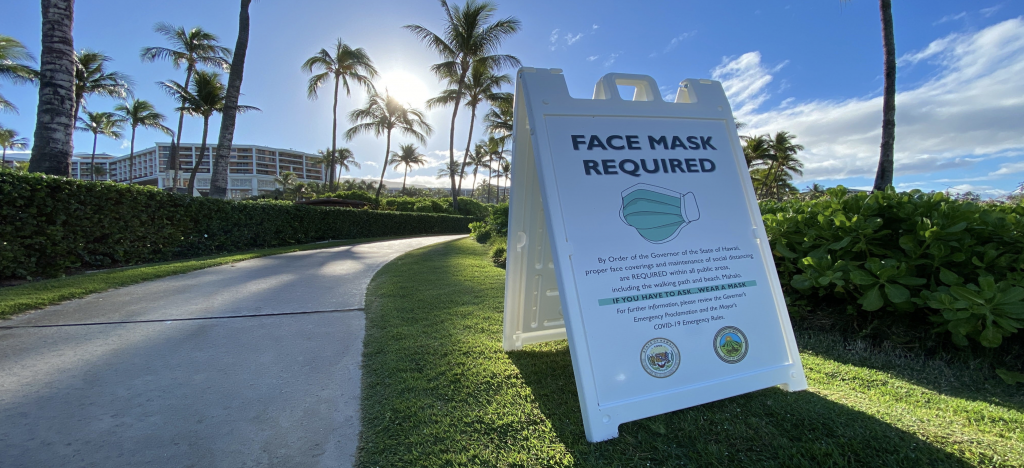Maui Hotels’ Average Daily Rate at $488, Up 54% from Pre-Pandemic September 2019

Despite lower occupancy, Maui County hotels earned $289 per available room in September 2021, which is 25.2% higher than pre-pandemic revenue in September 2019, according to the latest Hawaiʻi Hotel Performance Report from the Hawaiʻi Tourism Authority.
The main reason is the increase in the average daily rate of a hotel room on Maui, to $488, a whopping 54.4% higher than two years ago.
But Maui’s hotel occupancy continues to be affected by the ongoing COVID-19 pandemic, with 13.8% fewer guests in September 2021 compared to September 2019.
Maui’s luxury resort region of Wailea had an average daily rate (ADR) of $682 and a revenue per available room (RevPAR) of $366, with an occupancy of 53.7 percent (-28.7 percentage points vs. 2019).
The Lahaina/Kaanapali/Kapalua region had an ADR of $416 and ADR at $416, with occupancy of 62% (-9.8 percentage points vs. 2019).
Hawaiʻi hotels statewide reported higher ADR in September 2021 than two years earlier, but RevPAR was lower due to less occupancy.
Statewide RevPAR in September 2021 was $168 (-13.5% vs. 2019), driven by a 23.8 decrease in occupancy. However, the statewide RevPAR in September was helped by the increasing rates of hotel rooms, which were 23.7% higher in September 2021 than September 2019.
“Hawaii’s hotel industry saw a decrease in September RevPAR and occupancy statewide compared to September 2019, in part due to the effects of the Delta variant that stymied travel demand,” said John De Fries, Hawaiʻi Tourism Authority President and CEO. “This reminds us that the pandemic is not over and we must remain vigilant to keep our communities safe and economic recovery on track.”
The report’s findings utilized data compiled by STR, Inc., which conducts the largest and most comprehensive survey of hotel properties in the Hawaiian Islands. For September, the survey included 144 properties representing 46,094 rooms (85.4% of all lodging properties and 86% of operating lodging properties with 20 rooms or more in the Hawaiian Islands, including those offering full service, limited service, and condominium hotels). Vacation rental and timeshare properties were not included in this survey.
In September 2021, passengers arriving from out-of-state could bypass the State’s mandatory 10-day self-quarantine if they were fully vaccinated in the United States or with a valid negative COVID-19 NAAT test result from a Trusted Testing Partner prior to their departure through the Safe Travels program. On Aug. 23, 2021, Hawaiʻi Governor David Ige urged travelers to curtail non-essential travel until the end of October 2021 due to the Delta variant resulting in the state’s health care system being overburdened.
Hawaii hotel room revenues statewide rose in September to $270 million (although still 13.2% less vs. 2019). Room demand was 887,100 room nights (-29.8% vs. 2019) and room supply was 1.6 million room nights (+0.4% vs. 2019).
Many properties closed or reduced operations starting in April 2020 due to the COVID-19 pandemic. Due to these supply reductions, comparative data for certain markets and prices classes were not available for 2020; and comparisons to 2019 have been added.
First Nine Months of 2021:
Through the first nine months of 2021, Hawaiʻi hotel performance statewide continued to be impacted by the COVID-19 pandemic. Hawaiʻi hotels earned $177 in RevPAR (-22.3% vs. 2019), with ADR at $317 (+13% vs. 2019) and occupancy of 55.9 percent (-25.3 percentage points vs. 2019).
Total statewide hotel revenues for the first nine months of 2021 are $2.5 billion (-25.5% vs. 2019). Room supply was 14.1 million room nights (-4.1% vs. 2019) and room demand was 7.9 million room nights (-34.0% vs. 2019).
Comparison to Top U.S. Markets:
In comparison to the top US markets during the first nine months of 2021, the Hawaiian Islands earned the highest RevPAR at $177 (+49.0%). Miami, FL was second at $143 (+52.3%), followed by New York City at $101 (+29.8%).
The Hawaiian Islands also led the US markets in ADR at $317 (+16.5%), followed by Miami at $216 (+8.1%) and New York City at $182 (+16.6%).
With the US Mainland accessible for road trips and short-haul inter-continental flights, the Hawaiian Islands’ occupancy continued to be lower than many destinations in STR’s top 25 markets; landing at the 11th spot. Tampa, FL topped the country in occupancy at 68.9 percent (+17.4 percentage points), followed by Miami at 66.1 percent (+19.2 percentage points), and Norfolk/Virginia Beach, VA at 63.6 percent (+13.7 percentage points).
Comparison to International Markets:
Hotels in the Maldives ranked highest in RevPAR for international “sun and sea” destinations at $337 (+46.2%), followed by French Polynesia ($315, +29.9%) and Maui County ($303, +81.9%). The island of Hawaii, Kauai, and Oahu ranked fourth, sixth, and ninth, respectively.
French Polynesia led in ADR at $718 (+30.1%), followed by the Maldives ($656, -11.7%) and Maui County ($517, +26.1%). The island of Hawaii, Kauai, and Oahu ranked fifth, sixth, and ninth, respectively.
Puerto Rico led in occupancy for “sun and sea” destinations at 63.7 percent (+30.1 percentage points), followed by Maui County (58.7%, +18 percentage points) and Hawaii Island (58.4 percent, +12.1 percentage points). Kauai and Oahu ranked fifth and sixth, respectively.
To view full report, including data on other Hawaiian islands, click here.








